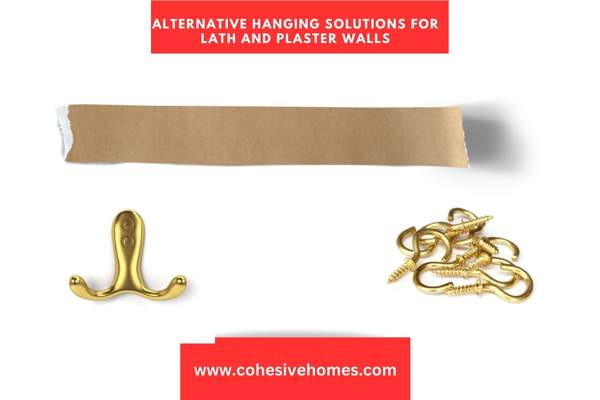How To Hang Curtains On Lath And Plaster Walls? There’s something special about having curtains that can add a touch of style and elegance to any room. But when you’re dealing with walls made out of lath and plaster, hanging curtains can be a tricky task.
Lath and plaster walls are not as common as regular drywall, but they are still used in some homes and offices.
The problem is that because the plaster is thin and brittle, it can be difficult to find a way to hang your curtains without damaging the walls or compromising their integrity.
But don’t worry! In this article, I’ll give you all the information you need to hang beautiful curtains on lath and plaster walls.
I’ll share my best tips and tricks, along with step-by-step instructions on how to do it right. So let’s get started!
Understanding Lath and Plaster Walls

When it comes to hanging curtains on lath and plaster walls, it’s important to understand what you’re dealing with first.
Lath and plaster walls are an older style of walling that is created using a combination of thin wooden strips or laths and a wet plaster material.
This combination makes them thicker than drywall and more prone to movement, so it’s important to have the right hardware on hand when hanging your curtains.
When dealing with lath and plaster walls, the best way to hang your curtains is by using specialty curtain rods that come with an adjustable bracket.
This bracket allows you to move the rod up or down depending on the thickness of the wall, so that you get an even grip, no matter what.
Using heavy-duty wall anchors is also recommended for lath and plaster walls, as these will provide extra strength for heavier curtains or for rooms that get more traffic.
Anchoring into wood studs will also help ensure that your rod won’t come crashing down in case of any unexpected movement from the wall.
Necessary Materials for Hanging Curtains

Hanging curtains on lath and plaster walls can be tricky business.
But with the right materials, you’ll be able to get the job done in no time! Here’s a list of the supplies you’ll need:
- An electric drill: this is essential for making precise holes in lath and plaster.
- Masonry bit: use this to easily drill into your walls.
- Wall plugs: these will ensure that your curtain rods are secure in the wall they are attached to.
- Screws: use these to hold the curtain rods in place against the wall.
- Curtain rods: pick one that fits your curtains of choice and matches your wall décor.
- Hammer – for hammering nails into your lath and plaster walls for use as an additional method of hanging curtains.
Once you have all these materials, you can get to work on hanging those curtains!
Always follow safety instructions when using drills and hammers, and make sure your screws are the correct size so they don’t damage any surrounding surfaces.
With patience and care, you’ll soon have attractive curtains adorning your lath and plaster walls!
Consider a Curtain Rod Bracket System

If you’re concerned about how to hang curtains on lath and plaster walls, don’t worry – there are solutions.
A curtain rod bracket system is the best option for hanging curtains on lath and plaster walls.
This system consists of a hanger plate, brackets, and screws that attach to the wall, as well as special wooden or metal dowels that anchor the curtain rod in place.
The hanger plate makes it easier to evenly distribute the weight of the curtains across your wall, and the dowels act as an additional support system.
They also allow you to adjust the height of your curtains, which is great if you have uneven ceilings.
The key with this system is to ensure that all components are attached securely to the wall so they don’t come loose over time.
You can do this by making sure that you use proper anchors when attaching each piece, such as toggle bolts or masonry screws.
Once you’ve installed everything correctly, you can safely hang your new curtains and enjoy their beauty for years to come!
Installation Tips for Curtain Rods on Lath and Plaster Walls

Hanging curtains on lath and plaster walls can be tricky, but it’s definitely possible.
Here are a few things to keep in mind when you’re ready to get started.
Wall Anchors
First, you’ll want to make sure that you use wall anchors whenever possible.
This will help ensure that the wall is strong enough to support the weight of your curtain rod and curtains.
If your walls are made from lath and plaster, then it’s best to use plastic expansion anchors and screws, as these will avoid damaging the fragile surface of the wall.
Wooden Dowels
Another helpful tip is to use wooden dowels instead of screws to attach your curtain rod brackets to the wall.
This will help avoid drilling into the lath and plaster and will create a stronger, more secure mount for your curtain rod.
Wall Anchor Screws
Finally, make sure that you don’t overtighten your wall anchor screws when attaching your brackets.
Overtightening could cause problems with the fragile lath and plaster, so be sure to only tighten them enough for them to hold securely in place.
With these tips in mind, you should have no problem hanging curtains on lath and plaster walls!
Alternative Hanging Solutions for Lath and Plaster Walls

If you have lath and plaster walls, hanging curtains can be a bit tricky.
You may need to find an alternative solution to ensure that your curtains are safely and firmly attached.
Here are some solutions that you can consider if traditional curtain rods don’t do the trick:
Adhesive Strips
Adhesive strips come in many forms and sizes, allowing you to securely attach your curtains without using a traditional curtain rod.
This method is ideal if your walls are delicate or you need a temporary solution.
Just make sure to use heavy-duty adhesive strips that can support the weight of your curtains.
Hooks or Rings with Screws
You can also try using hooks or rings with screws for hanging curtains on lath and plaster walls.
This method is more secure as the screws will grip into the wall better than an adhesive strip will, providing more stability for any heavier curtains.
All you will need is some strong hooks or rings and the right size screws for attaching them to the wall.
Picture Rails
If all else fails, picture rails are another great option that provide more stability than adhesive strips or hooks and screws.
With picture rails, you just attach them to your wall and hang the curtains from them—they’re easy to install and provide a secure way of hanging your heavier curtains without damaging the integrity of your walls.
Whichever solution you choose, make sure that it’s strong enough to hold up the weight of your curtains—nothing should be taking any unnecessary risks when it comes to decorating!
Troubleshooting Tips for Hanging Curtains on Lath and Plaster Walls

Hanging curtains on lath and plaster walls presents a unique challenge, but you can overcome it by using the right tools and knowledge.
And if you encounter any issues along the way, here are a few troubleshooting tips to help you out.
Use the Correct Hardware
When hanging curtains on lath and plaster walls, it’s important to use the right type of hardware.
This includes specifically sized screws and wall anchors that won’t crack or break the wall, as well as curtain rods that are sturdy enough to hold up against the weight of your curtains.
Don’t Over-tighten Rods
Another thing to keep in mind is not to over-tighten your screws or rods when attaching them to the lath and plaster walls; this can cause them to crack or break.
To ensure your curtains stay in place without compromising the integrity of your wall, make sure you’re using light pressure when tightening any screws or bolts.
Use Dampeners
Finally, using dampeners can help reduce some of the noise caused by vibrations from opening and closing your curtains.
These special plugs attach to your rod and absorb some of the vibrations so they don’t reverberate through your wall, helping you keep peace and quiet in your home.
Conclusion

Installing curtains on lath and plaster walls may seem like an intimidating endeavor, but with a little bit of patience and the right tools, you can hang curtains on your walls with ease.
The key is to choose the right hardware for the job, so that you can ensure your curtains are securely hung and level.
And with the right materials and installation methods, you can rest assured that your curtains and walls remain secure, even on a lath and plaster wall.
Whether you’re in need of a bit of privacy or simply looking to add a decorative touch to your walls, with the proper technique and materials, you can hang curtains on your lath and plaster walls in no time.
FAQS
What kind of hardware should I use to hang curtains on lath and plaster walls?
Use picture hanging hooks or toggle bolts that are strong enough to support the weight of your curtains.
How can I find the studs behind the plaster to hang my curtains?
Use a stud finder, tap the wall to listen for a solid sound, or make a small hole to see if you hit a stud.
How do I ensure that my curtains hang straight and level on lath and plaster walls?
Measure carefully, mark the placement of your hardware before drilling, use a level to ensure that your curtain rod is straight, and make small adjustments if necessary.
